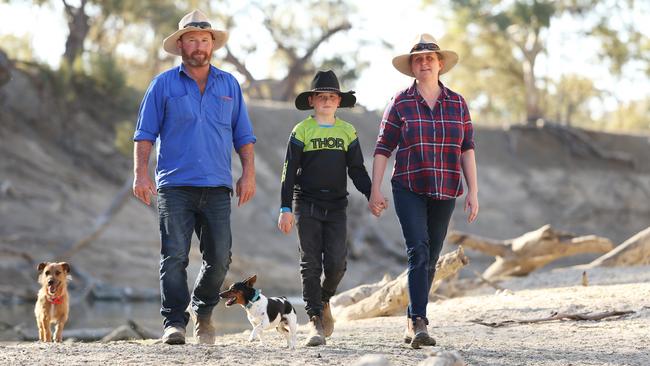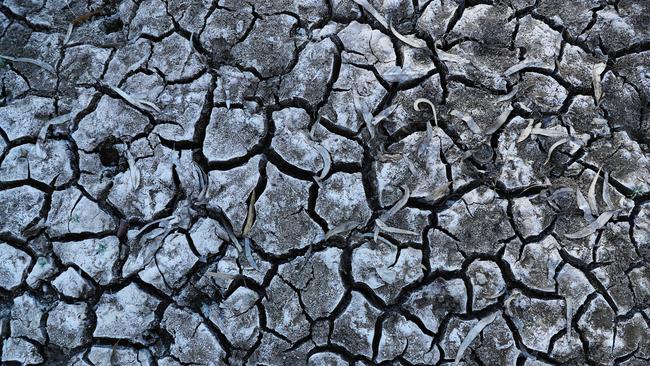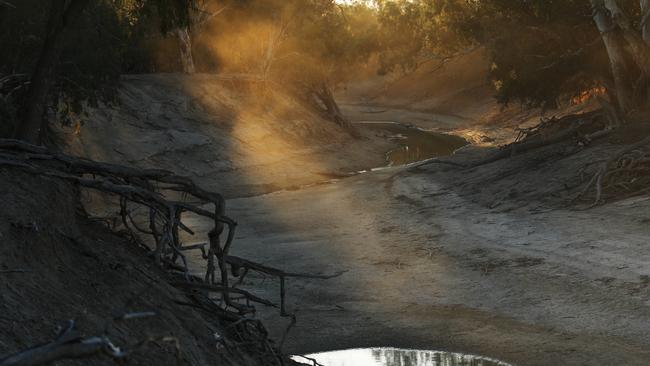Anger as floodwater lost to farmers 10 years after dams should have been removed
Families on the lower Darling are helplessly watching the last puddles of river water dry up, as an upstream discovery delays the planned removal of dam walls.
NSW
Don't miss out on the headlines from NSW. Followed categories will be added to My News.
- Water Minister defends attack on Murray-Darling plan report
- $70m to restock the Murray Darling after fish deaths
Families on the lower Darling are helplessly watching the last puddles of river water dry up, as the planned removal of dam walls upstream has been delayed by the discovery of “highly sensitive” indigenous artefacts.
Residents south of Menindee — where water has not flowed down river since February — are furious the state government missed an opportunity to push two billion litres of extra floodwater from a cyclone in Queensland downstream earlier this year.
That’s because it has yet to modify the dam walls at a property which was purchased for that purpose a decade ago.
Then-federal minister Penny Wong spent $24 million buying Toorale Station in northwest NSW in 2008, under a plan to return water downstream.
RELATED
From dust to oasis for rural town of Menindee

RELATED NEWS
Great River Run, Part One: The Big Picture
Murray Darling crisis: Getting to the heart of tragic treasure
Inside the cotton farm accused of bleeding the Darling dry
The responsibility for the structural work — including pulling down old dams and upsizing pipes to allow the water to flow — was handed to state authorities.
But 10 years later the NSW government is yet to commence the work.
The Daily Telegraph can reveal the project was delayed during planning due to “highly sensitive cultural heritage, environmental and neighbouring landholder water interests”.
NSW Water Minister Melinda Pavey said the Toorale Infrastructure Project was a NSW National Parks responsibility.
“I am working closely with Environment Minister Matt Kean to ensure future flows are delivered down the river as originally envisaged when Toorale was purchased,” Ms Pavey said.

A meeting last week between Menindee locals, state and Commonwealth officials was told an indigenous artefact possibly 50,000 years old was among the significant findings on the site.
Landowners at that meeting were angry to learn that of the 30 gigalitres of floodwater to reach Toorale in April after Cyclone Trevor, only 25 gigalitres could be pushed straight into the Darling because the pipes on the dam are too small. Commonwealth authorities estimate up to two billion litres of extra water could have reached Menindee if the dams at Toorale had been opened up.
Federal Water Minister David Littleproud said he had written to Mr Kean in July, saying he expected the work at Toorale to now be completed. “I now expect them to get on with the job and get it done,” Mr Littleproud said.

Karoola Station owner Wayne Smith, who has been left pumping water out of a shrinking pool on the river to feed his sheep, said the extra floodwater from Queensland could have helped save more protected fish species this summer.
“The Barwon Darling review shows the river was in drought three years sooner than it should have been,” Mr Smith said. “Had there been water in the river when the extra flow came down from Toorale, that could have travelled a lot further.”
Mr Smith has temporarily lost organic certification for his lambs because the putrid water the animals have to drink doesn’t meet strict standards. “So long as we keep dealing with sections of river in isolation and not considering the downstream impacts, there will be problems like this,” he said.

Mr Smith said landowners in the area were “devastated” by the mass fish kills last year, and are preparing for an even worse disaster this summer. “I’m already picking up the odd dead Murray cod, big fish up to 1m long, in the small pools of river around my property, and it’s not even that warm yet,” he said.
A scathing National Resources Commissioner report released late last week estimated changes to extraction rules in 2012 caused persistent “very low” flows in the lower Darling three years earlier than the river upstream.

NRC chair Dr John Keniry made recommendations designed to deliver water downstream during periods of drought or low flow. He found the use of water for irrigation on farms in the northern parts of the river was preventing water reaching landowners and towns further south — and that those competing needs must be balanced.
Ms Pavey said she would carefully consider the report and respond in an “appropriate time frame”.
Shooters, Fishers and Farmers Party Barwon MP Roy Butler said it was “not helpful” to pit north and south river users against each other, and the focus should instead be on the government’s rules.
“Whether it’s the agriculture industry, town communities, or Aboriginal people who rely on access to water for cultural purposes, I don’t think we want to enter a debate about who has a greater right to water,” Mr Butler said. “The government is the regulator responsible for making and enforcing the rules … and trust in government decision-making is at an all-time low.”
BURNING QUESTION FOR TOWNS IN DROUGHT
Drought-stricken towns and communities face the heartbreaking prospect of having to watch their homes burn down because there is not enough water to fight a bushfire.
As more than 65 blazes burned across the state in the worst start to a bushfire season on record, firefighters warned many towns face a horrific choice.
If a fire threatens, many communities will be left asking: “Do they have enough water to put it out”, Fire and Rescue NSW Warialda station commander Colin Cuell said yesterday.
“And what impact would that have on the drinking water supply?
“It is a heartbreaking choice and no one wants to make it — but we’re in a drought where some people don’t have enough water for drinking or showering.
“Do you use water for drinking or save water up to help to put out fires?”

RELATED NEWS
How fireys fight bushfires without water
Ominous warning: ‘We’re in for a horrific bushfire season’
Firestorm destroyed Penny’s home in just 20 minutes
Mr Cuell said in some cases firefighters would be left with little option other than to back-burn a firebreak around a property under threat from flames — and then hope for the best.
“There is nothing we can do about this,” he said.
“We just need rain, we are all praying for rain.”
But towns like Tenterfield refuse to be beaten.
In an extraordinary move, 600,000 litres a day of greywater from local showers and toilets are being pumped into trucks to fight the fires that began last Friday.

And semi-trailers are also carting water in, while some fire trucks will be able to be filled direct from bores.
Warialda firefighter Aaron Brooks said there is little hope of stopping bushfires without water.
“Because of the drought, everything is just dead — dead trees, dead grass,” he said. “You notice it when you walk through the bush everything cracks underneath your feet.
“All of that is just fuel for the fire. If they (fires) get going in that stuff, there is no stopping them.”
Fires have raged from the Tweed, on the Queensland border, south to Bega since Friday, with more than 450 firefighters and 170 fire trucks and aircraft called in to the battle. Yesterday afternoon, more than 65 fires were burning — at least 20 of them uncontained — razing 100,000ha of land and six homes in northern NSW.
The two most concerning blazes were at Bees Nest, near Armidale and at Long Gully Rd, near Tenterfield.
Neville Smith, 66, who was injured while fighting a fire in Tenterfield on Friday, was in a critical condition at the Royal Brisbane and Women’s Hospital last night.
The father of two had made a slight improvement yesterday and his friend of 25 years Irene Horn said the whole town was behind him.
“He is the most honest and caring man I’ve ever met,” she said.
“He helps everyone in the community, if anyone ever needs a hand he’s the first to help.”

Strong winds were threatening to increase the inferno, but the weather bureau forecast conditions to ease today — but warn the rest of the year is expected to be hotter and drier than usual.
In Queensland, where more than 50 fires were burning and 20 homes already lost, Fire and Emergency Services inspector Andrew Sturgess said: “This is an omen, if you will, a warning of the fire season that we are likely to see.”
— Mitchell Van Homrigh
